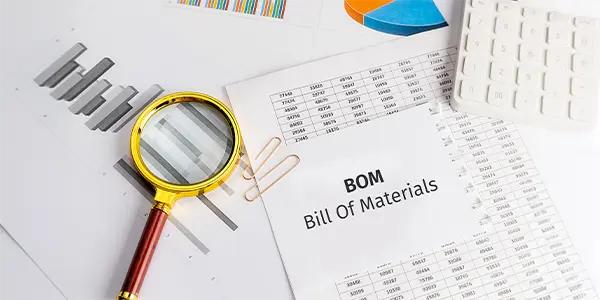
In complex capital projects, where several stakeholders, materials, and systems must align, clarity and precision are non-negotiable. At the core of efficient project execution lies the bill of materials (BOM). This document provides a structured list of all components needed to build, maintain, or repair an asset. Whether in manufacturing, construction, or major turnarounds, the BOM serves as a blueprint, ensuring that the right materials are ordered, tracked, and used at the right time.
Without a well-managed BOM, project teams might face miscommunication, cost overruns, and delays. With it, organizations gain transparency, control, and the ability to deliver projects more efficiently and accurately.
Bill of Materials Definition
A bill of materials (BOM) is a comprehensive list of materials, components, assemblies, and sub-assemblies required to build a product or asset. It is often described as the “recipe” for building, specifying each item’s quantity, part number, and description.
In capital projects, the BOM guides procurement, engineering, and construction teams. It ensures everyone works from the same data, which reduces discrepancies and rework. In short, the BOM bridges planning and execution by transforming designs into physical reality.
Types of Bill of Materials
Different projects require different types of BOMs, each serving a specific purpose. Common types include:
- Engineering BOM (EBOM): Derived from the design phase, the EBOM outlines parts and assemblies as defined by engineers. It reflects the technical specifications of a product or asset.
- Configurable BOM (CBOM): A Configurable BOM allows teams to tailor components and assemblies based on project-specific requirements. In complex construction or turnarounds, CBOMs help planners adjust spare parts or work packages without creating a completely new BOM for each variation.
- Single-Level BOM: A Single-Level BOM lists only the top-level components or assemblies required for a project or asset. It works well for straightforward tasks or smaller maintenance projects where simplicity and quick reference are priorities.
- Multi-Level BOM: A Multi-Level BOM organizes assemblies hierarchically, showing sub-assemblies, components, and final assets. This structure is essential for construction projects or turnarounds, enabling precise scheduling, procurement, and coordination of all dependencies.
By understanding and using various types of BOMs, capital project and turnaround professionals can optimize production processes, but also enhance planning and communication across disciplines construction and maintenance projects.
Bill of Materials Asset Management

In asset-intensive industries, an asset management BOM plays a vital role. It links equipment and facilities with the spare parts, consumables, and sub-components needed for maintenance. This BOM typically includes:
- Equipment identifiers
- Spare parts lists
- Vendor details
- Maintenance intervals
In complex construction projects, shutdowns, and turnarounds, the bill of materials is a critical planning tool. For example, a refinery turnaround BOM may include gaskets, valves, safety gear, and scaffolding materials, which are all tied to specific maintenance tasks. By connecting these requirements with procurement schedules, project teams can ensure that the right parts arrive on-site exactly when needed, minimizing costly downtime.
Why is a Bill of Materials Important?
The value of a bill of materials extends far beyond a simple list. It enables project and turnaround professionals to:
- Reduce costs: With accurate material forecasts, organizations avoid over-ordering and minimize waste.
- Boost efficiency: Procurement, engineering, and field teams align on material requirements, reducing delays.
- Improve accuracy: Having all information in a centralized place reduces errors caused by fragmented data sources.
- Strengthen planning: In complex projects and turnarounds, BOMs help synchronize maintenance schedules, spare part deliveries, and contractor work packages. Therefore, BOMs reduce idle time and improve schedule certainty.
When integrated into a project controls software like Cleopatra Enterprise, BOMs become even more powerful as they connect cost, schedule, and materials data in one place.
Creating a Bill of Materials
Developing a clear and accurate BOM requires a structured approach. Project professionals typically follow these steps:
- Identify the product or asset scope: Start by clearly defining what needs to be built, assembled, or maintained. This could mean specifying which systems, equipment, or units are included in the BOM. A well-defined scope helps avoid gaps that often lead to costly delays later.
- List all components: Break the scope down into the required parts, materials, and consumables. For example, in a turnaround, this might include spare parts for critical equipment, piping materials, or safety gear. The more complete this list is upfront, the less risk of surprises you will have during execution.
- Assign unique identifiers: Every item should have a clear code or part number to avoid confusion. Furthermore, standardized identifiers make it easier for engineering, procurement, and operations teams to work from the same reference point and prevent duplicate orders.
- Specify quantities and units: Effective planning requires accurate quantities. It is important to define the exact units (e.g., meters of pipe, liters of chemicals, or number of valves) to reduce the risk of procurement mistakes or material shortages.
- Validate with stakeholders: Before finalizing the BOM, cross-check it with key teams such as engineering, procurement, and operations.
Components of a Bill of Materials
A well-structured bill of materials typically includes:
- Part numbers: Unique identifiers for each item
- Descriptions: Clear details of the part or material
- Quantities: Number of units required
- Units of measure: Standardized measurement (e.g., kg, m, pcs)
- Procurement details: Vendor, lead time, or cost information
- Revision level: Version control to track changes
These elements help ensure consistency, traceability, and alignment across teams.
Tips for Managing a Bill of Materials

Even with a structured bill of materials, project teams can face challenges if the document isn’t maintained properly. Here are key practices to ensure your BOM remains accurate and actionable:
- Capture complete and accurate data: Missing items, vague descriptions, or wrong quantities can cause procurement delays and drive up costs. In large projects, even a minor oversight (e.g., underestimating pipe fittings) can lead to schedule delays.
- Standardize part numbers and naming conventions: Doing so will ensure consistency across teams and reduce errors or duplication.
- Keep the BOM updated: Projects evolve constantly with design changes, supplier shifts, and scope adjustments. Regular updates and version control ensure teams always work with the latest information, avoiding costly rework.
- Ensure cross-team alignment: Engineering, procurement, construction, and maintenance teams must collaborate on the BOM. Shared platforms and clear communication channels prevent misunderstandings and ensure smooth execution.
- Integrate with project control systems: Linking the BOM to scheduling, cost, and procurement tools (like ERP or project controls software) provides real-time visibility. This integration eliminates data silos, reduces manual work, improves traceability, and ensures decisions are made on current data.
By following these practices, project professionals can turn the bill of materials into a reliable foundation for cost control, procurement planning, and successful project delivery.
A well-prepared bill of materials not only supports efficient procurement and execution but also underpins the entire lifecycle of an asset. By leveraging project controls software platforms like Cleopatra Enterprise, organizations can ensure their BOMs are accurate, connected, and actionable. A well-managed BOM can also feed into cost estimating software, helping teams quickly draft estimates, validate budgets, and forecast expenditures alongside project schedules and material planning.
According to Dodge Construction Network’s survey, 70% of owners and contractors agree that better communication and coordination across…
Operational efficiency in project management is about achieving more with less: delivering projects on time and within budget…
Related resources
Defining and Creating Resource Breakdown Structures (RBS)
In this blog, we look at Resource Breakdown Structures, how to create them, their benefits, and practical tips for implementation.
Read blog article
How to Successfully Integrate CAPEX Projects in STO Events
This blog discusses why capital (CAPEX) projects take place during turnaround (STO) events and discusses areas that need to be optimized for successful integration.
Read blog article